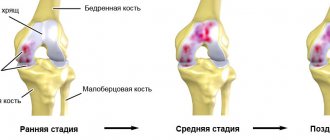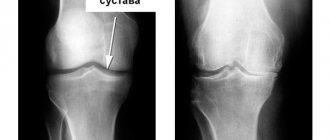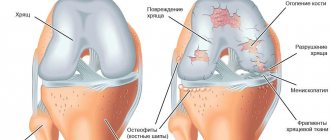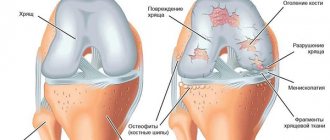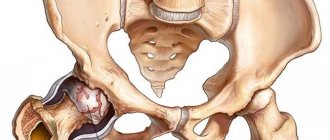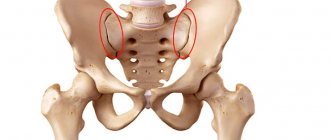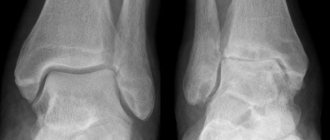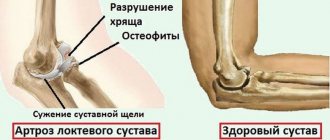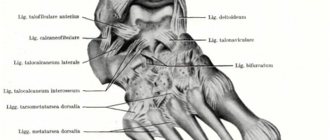Author of the article: Nivelichuk Taras, head of the department of anesthesiology and intensive care, work experience 8 years. Higher education in the specialty “General Medicine”.
Article publication date: 12/03/2014
Article updated date: 12/02/2018
Arthrosis is a disease of the joints in which damage (destruction) of all its tissues occurs: cartilage, synovial (joint lining), ligamentous and bone. At first, changes occur quite slowly and are practically asymptomatic - which is why diagnosing arthrosis of the 1st degree is not easy. Most often, patients consult a doctor with severe symptoms and advanced disease. Read further: what are the causes of the disease, how to recognize it at an early stage, what modern treatment methods exist.
The development of arthrosis goes through 4 stages (degrees). The first stage is characterized by minor changes in articular tissues. The first tissue to take the blow of the disease is the synovial membrane lining the inner surfaces of the joint. The composition of synovial fluid, which moisturizes the cartilage and meniscus of the joints, also changes. The usual load becomes increased for the cartilage, it cannot withstand it and begins to collapse, pain and inflammation develop.
Main causes of the disease
Arthrosis most often occurs in older patients, and the disease rarely affects children and adolescents. With pathology, one joint usually suffers, and not several (as often happens with arthritis). The main causes and risk factors for the development of arthrosis:
- genetic predisposition,
- injuries,
- the presence of other joint diseases,
- excessive physical activity,
- excess body weight,
- age 45 years and older,
- metabolic disorders,
- hormonal imbalances,
- violation of articular circulation,
- “harmful” professional activity,
- previous surgical interventions on the joint.
Reasons for development
The main reasons for which stage 1 arthrosis develops include:
- Congenital factor. In young children, flat feet and joint hypermobility are often diagnosed, which are the cause of improper intrauterine development of connective tissues. This causes damage to cartilage tissue and the development of pathological processes.
- Age. After 40-45 years, the process of tissue restoration gradually slows down in people, while the load on the body usually does not decrease, which can lead to the development of the disease. However, recently, arthrosis has become increasingly common at a young age, in people 25-30 years old.
- Genetic predisposition. A gene defect leads to the appearance of underdeveloped cartilage tissue. As a result, stage 1 osteoarthritis develops from early childhood.
- Heredity. Over the course of several generations, problems with the musculoskeletal system can be traced.
- Concomitant diseases. In 10% of cases, the development of the disease is caused by other diseases. For example, problems with hormonal levels or metabolic diseases.
- Injuries. The initial stage of arthrosis may appear as a result of a recent injury, most often these are fractures of the bones that form the joint.
- Overload of the joint - perhaps the most common cause is excess weight, which causes arthrosis of the joints of the legs.
Also, arthrosis of the first degree often develops in athletes and people engaged in heavy physical labor (loaders, builders, installers).
Characteristic symptoms
Arthrosis at the initial stage usually does not have pronounced symptoms, often they are absent altogether. The most characteristic signs for the first degree:
- rapid fatigue of the affected limb (area),
- crunch in the joint,
- muscle stiffness,
- minor restriction of movement.
Pain and inflammation are minor or absent. On x-rays, stage 1 arthrosis can sometimes be recognized by the narrowing of the interarticular space.
On the right – normal, on the left – narrowing of the joint space
What is osteoarthritis and what to do about it?
The disease causes destruction of the cartilage and bone tissue of the joints.
Stage 1 is characterized by thinning of the articular cartilage up to 2 mm (the norm is 2.5-2.7 mm), moderate swelling of the tissues, and disturbing pain, as a rule, only after physical exertion. Today there is no way to completely restore the affected joint, but under the supervision of an experienced doctor using modern treatment methods, it is possible to eliminate the symptoms, significantly slow down the progression of the disease and improve the quality of life.
Orthopedic doctor Andrey Sergeevich Litvinenko comments:
Typically, patients rarely go to the doctor and attribute initial arthrosis to a natural state of the body, such as overwork, which leads to a worsening of the situation. At the same time, not every doctor is able to diagnose the disease at the initial stage; it is better not to save money and immediately contact an experienced specialist.
Four best treatments
Treatment for grade 1 arthrosis can vary and depends on the severity of symptoms. The main goal of treatment is to reduce the load on the diseased joint, eliminate symptoms and prevent progression of the disease. For this, 4 methods are used:
- Medicines. Typically, patients are prescribed chondroprotectors - drugs that help normalize the structure of cartilage. Analgesics and non-steroidal anti-inflammatory drugs can also be used - they are indicated for patients suffering from pain and inflammation, which can also bother a patient with grade 1 arthrosis.
- Physiotherapy. Thanks to exercises, joint mobility is restored, even if it has been slightly lost.
- Massage. A high-quality massage allows you to achieve pain relief and complete restoration of mobility.
- Special diet. By correcting nutrition (routine, habits and diet), the body begins to receive sufficient amounts of beneficial substances that stimulate metabolism, cartilage restoration and block the production of enzymes that provoke inflammation. People who are overweight can lose weight, which will ease the strain on their joints.
For grade 1 arthrosis, surgical treatment is not performed. It is currently impossible to completely cure the disease, even if detected at the first stage, but it is quite possible to significantly slow down (stop) its progression. The above treatment methods will help with this, and all efforts should be directed towards achieving this goal.
Degree of severity of gonarthrosis
During the course of the disease, there are three degrees of severity. For stage 1 arthrosis of the knee joint
characterized by mild symptoms. During this period, the patient may experience slight pain in the knee area after prolonged physical exertion. After reducing the load on the joint, the pain disappears. Usually this is not given importance, and the person misses the onset of the disease. Without appropriate treatment, arthrosis progresses to the next stage.
In the later stages, the pain becomes pronounced and does not disappear after rest; crunching, swelling, and stiffness appear in the joint. The patient cannot move the affected leg in full, which leads to a deterioration in the quality of life and loss of performance. In severe cases, movement without assistance becomes impossible. The lack of professional and well-chosen drug treatment leads to disability.
Conclusion
The initial stages of gonarthrosis are considered relatively mild. Timely treatment of the disease can stop its progression and prolong the remission stage for many years. For arthrosis of the knee joint 1st degree
Complex conservative therapy is used, including the use of analgesics and chondroprotectors. The patient must undergo physical therapy and exercise therapy. It is important to understand that treatment is long-term and should only be carried out under the supervision of a specialist.
Stages of arthrosis
Primary. It is characterized by “pulling” sensations in the popliteal region and minor pain symptoms that disappear at rest.
Deforming arthrosis of the knee joint of the 2nd degree is usually manifested by increased pain symptoms, limited mobility of the joint, the appearance of a crunch during flexion-extension movements, as well as swelling. Treatment of the disease at this stage must be carried out immediately.
The third stage of defarthrosis most often cannot be treated and requires surgical intervention. With this course of the disease, joint deformation, severe limitation of movements, and lameness are observed. There is constant severe pain even at rest.
Only a qualified specialist, who can be found at the DaliMed clinic in St. Petersburg, can determine the degree of development of the disease. When diagnosing gonarthrosis, ultrasound and X-ray examination methods are used, as well as other laboratory examinations, which allow obtaining the most complete information about the patient’s health status.
Lack of therapy can provoke the development of an advanced stage of arthrosis, which will require surgical intervention.
Causes of deforming arthrosis
Articular cartilage is very thin - only 3 millimeters, and has a low ability to recover. This causes frequent damage to it as a result of direct mechanical injuries or as a result of inflammatory diseases accompanied by inflammation of the joint (arthritis). A decrease in the thickness of the articular cartilage or cracking leads to disruption of the load distribution mechanism and damage to the underlying bone, which in turn responds with active growth with the formation of spines - osteophytes and joint deformation. The main manifestations of deforming arthrosis are pain during exercise, “starting” pain that goes away after some time of walking, and swelling of the joint. Patients note crunching and clicking in the affected joint.
Arthrosis - main symptoms and signs by degree
The disease affects any joint, but the knees, small joints of the hand and foot, hip joint and spine are most often affected. Degenerative changes in joints occur unnoticed until the pathological process touches the periosteum. Therefore, at the initial stage, arthrosis does not manifest itself in any way.
There are three stages in the mechanism of disease development. Each stage has its own characteristics of joint damage.
Signs of arthrosis according to the degree of development of the process
First degree.
- subjectively, the first degree is asymptomatic, sometimes there is some discomfort when moving;
- objectively, the joint is normal, but already at this stage the composition of the synovial fluid changes due to a decrease in the synthesis of proteoglycans by chondrocytes and a weakening of muscle tone is observed.
Second degree.
- subjectively - the patient complains of pain in the joint when putting a load on it, usually in the late afternoon (during rest the pain disappears), characteristic crepitus is heard in the sore joint, especially when it is flexed and extended.
- objectively – the joint begins to deteriorate, collagen fibers disintegrate, marginal osteophytes appear, and the functions of the muscles adjacent to the joint suffer.
Third degree
- subjectively – severe pain not only during movement and load, joint deformation; limitation of range of motion; crunching heard from a distance, unnatural position of the limb
- objectively - almost complete destruction of cartilage, along the edges of the epiphyses, cartilage grows and ossifies, cartilaginous detritus is detected in the cavity, tendons and surrounding muscles are involved in the process
Main symptoms of arthrosis
The disease can go unnoticed for a long time. Occasionally, with some movement or increased load, pain may appear, which quickly passes. The patient does not pay attention to periodic illness and does not consult a doctor. But we must remember that the degeneration of the process continues outside of subjective sensations. If the patient is not treated, the disease can lead to immobility.
The main symptoms of arthrosis:
- Pain
A painful sensation is typical when starting to move after a period of rest; after 10-15 minutes it disappears. Usually the pain is aching. In a calm state, the pain goes away; it does not bother you during sleep. Sometimes pain can appear in the morning (patients complain of a “lumbago”). The pain may worsen during inclement rainy weather.
- Change in appearance of the joint.
As the disease progresses, the joint increases in volume due to the accumulation of synovial fluid. Synovitis is characterized by an increase in local temperature. Severe joint deformation appears in the stage of decompensation and is caused by the growth and ossification of cartilage.
- Crunch
The disease is characterized by a specific dry crunch in the affected areas, which occurs due to friction of bone formations and is accompanied by pain.
- Reduced range of motion.
Due to the weakening of the ligamentous apparatus, muscle hypotonicity, and a decrease in the joint space, joint mobility decreases and the biomechanics of the body suffers.
A characteristic feature of the disease is that the patient’s general condition suffers little. Usually there is a slowly progressive course.
In older people, a generalized form of arthrosis (polyostearthrosis deformans) is observed. Its characteristic features:
- Simultaneous symmetrical damage to several joints.
- Rapid spread of the process.
- Early occurrence of reactive synovitis.
The variety of forms of arthrosis and the high frequency of concomitant pathologies require careful and thorough diagnosis to develop individual treatment tactics.
